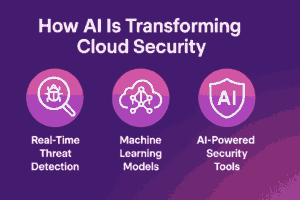A breach in one of your systems was executed, your IT team went into full swing, and damage was already inflicted. However, in the year 2025, companies would no longer be content to wait till the fire breaks out to seize the fire extinguisher. They require early-warning alarms and those that are never-freezing and sprinklers that prevent it in real-time.
That is where cloud security supported by AI is altering the game. Combining the AI-driven ability to predict ransomware before it dispenses, to stopping suspicious logins in real time, the potential of AI is taking cybersecurity from damage control to damage prevention.
Why Cloud Security Has Become Mission-Critical
The way companies use technology has shifted dramatically in just five years. Today, 94% of enterprises worldwide use cloud services (Gartner) running everything from sensitive financial data to critical healthcare records in cloud environments.
But this massive migration has opened the floodgates to new cyber threats. According to the IBM Cost of a Data Breach Report 2025, the average cloud-related breach costs $4.6 million (IBM Report). For small and mid-sized businesses (SMBs), even a fraction of that can be devastating.
Key Challenges in Cloud Security
Companies of every industry are experiencing the same repeating pain points:
- Data breaches due to #missconfigcloud #cloud Security settings
- Ransomware that targets cloud-storage and collaboration platforms
- Insider threats where employees (accidentally or not) release sensitive information
- DDoS attacks overburden the websites and apps that are hosted by the cloud databases
The result? Nationally known big firms also beget down time, loss of revenue and damaged image not easily repaired.
How AI is Re-Question of the Cloud

So, how are they going to do that? AI is rewiring cloud protection wires in three primary ways.
-
Real Time AI Threat Detection
Traditional tools are associated with familiar signatures/rules. However, systems can detect abnormalities before it is too late by use of machine learning.
As an illustration, AI-based platforms are capable of:
- Logins to uncommon locations Flag suspicious logins to unfamiliar locations
- Identify the spreading malware through shared cloud folders
- Anticipate vulnerabilities prior to appear being exercised by attackers
Such proactive line of defense is essential nowadays when every 11 seconds somewhere around the world, ransomware attack occurs (CISA Guidance).
-
Machine Learning That Learns With You
The AI-driven systems do not need to be updated like before, an AI-based system would grow with a new dataset.
- Behavioral analysis – The ML knows how normal should look like in your business. When all of a sudden a contractor decides to pull 10GB of files at 2AM, this does not pass unnoticed.
- Anomaly detection – AI also compares activities to millions of other patterns around the world, which means that breaches are detected well before they are detected by a human.
- Automated reaction – Rather than raising an alert and waiting, AI can lock, quarantine a device and raise an IT alert instantly.
This transition minimizes the time taken to respond to attacks which is usually the difference between blocked and million dollars breaches.
-
Cloud Security Tools with AI-driven Technology
In 2025, the rate of AI-driven cybersecurity solutions is gathering pace. Businesses are no longer satisfied with firewalls and antivirus, but are going to integrated, intelligent systems.
Some of them are as presented:
- Cloud firewalls that perform traffic inspection and filtering on the basis of AI
- Real-time attack intelligence solutions such as the Google Chronicle and IBM Watson Security that ingest real-time attack data
- Identity and Access Management (IAM) solutions that identify improper logins with the help of AI
- Microsoft Defender Cloud, that can now leverage AI across billions of signals daily within Microsoft 365 and Azure
What this means is that there are reduced false alarms and quick response time, which in turn translates to better business security.
The Future of AI and Cloud Security
There is only increasing strength in cyber security AI. Theorists believe that in the next half a decade, there is going to be a shift, as automated security systems become the ones to handle a lot of functionality that currently falls under manual checks by the IT teams.
This is what will be experienced:
- Self-healing systems – AI that not only identifies the threat but also repairs the gap that probes without any manual intervention
- Predictive analytics – prediction of cyberattacks before they occur, parallel to the weather prediction model
- Compliance automation – The automatic compliance which AI provides with various laws such as GDPR, HIPAA, or PCI DSS
- AI-enhanced encryption – growing encryption algorithms that adjust to new forms of attack approach
Why Timing Matters Now
Cybercriminals aren’t slowing down. In fact, cybercrime damages are expected to reach $13 trillion globally by 2028 (Cybersecurity Ventures). SMBs and enterprises alike face a simple choice: evolve defenses or remain exposed. For a deeper look at these strategies, see our guide on reducing IT costs in logistics.
Summary
For the future of cloud security, it has nothing to do with attracting more human analysts and chasing after alerts to infinity. It concerns implementing AI technologies that operate in real time and can be used to predict risks and adapt to changes in the ways that attackers operate.
If your business trusts the cloud, the answer to whether you need AI driven security is not anymore when but rather can you afford another day without it.
AI won’t just enable businesses to survive cybercrime. It will determine which organizations would survive a digital-first future.
FAQs
-
Put plainly speaking, AI cloud security entails a protection system against attacks.
It employs artificial intelligence to identify, stop, and manage cyber threats in cloud systems without human intervention — and in most cases, quicker than human teams.
-
Is it possible for AI to stop ransomware entirely?
A tool cannot have a 100 percent protection level, but it significantly minimizes the risks, as the AI will identify the ransomware patterns within a few seconds and halt their propagation.
-
Is AI security exclusively to large businesses?
Not in the least. The cost of maintaining a 24/7 security in-house team led to many SMBs adopting the use of AI-based security solutions.
-
What are the most relied upon AI security tools in 2025?
Among the leading tools that one can use are Microsoft Defender Cloud, Google Chronicle and IBM Watson Security.
-
Which advantage of AI in cybersecurity is greatest?
Speed. Whereas, traditional systems notify you of an attack, AI does so in real-time one pause isolating devices, locking down logins or preventing malware execution.






